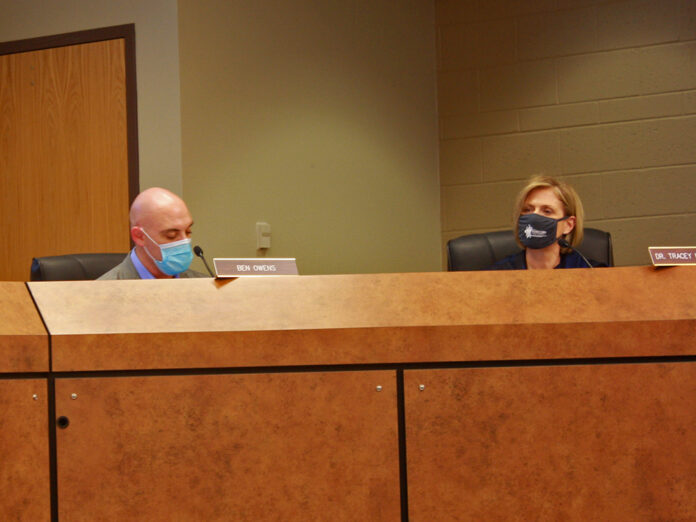
Students in the Maricopa Unified School District will be able to return the classroom on Monday.
But the situation is “volatile,” cautioned Superintendent Dr. Tracey Lopeman, with the number of student and staff coronavirus cases at several district schools making it possible quarantine will force a short-term return to distance learning.
MORE COVERAGE: MUSD votes to call budget override election
The Governing Board voted, 3-0, on Wednesday night to accept Lopeman’s recommendation to allow students opting for in-school learning to go back to class. Board member Torri Anderson did not attend the meeting.
Distance learning, for students and families who have opted for that mode of instruction, will continue through the end of the school year.
All MUSD students have been distance-learning since Winter Break. On Jan. 7, the board voted, 3-1, with Anderson dissenting, to suspend in-school lessons until at least Feb. 1 after a spike in positive cases following the holidays. Lopeman had recommended a return to class.
But the district has seen a week-over-week decline in positive cases since the beginning of the month. According to Lopeman, 146 district employees and students are expected absent next week due to COVID-19 or the Family Medical Leave Act. That number includes 21 teachers, 22 support staff, six in the transportation department and 97 students, including 29 at Maricopa Elementary, 24 at Santa Cruz Elementary and 16 at Maricopa High.
“There was a definite spike for Christmas and New Year’s,” said board member Jim Jordan. “The trend line is coming down now. It would be prudent to give parents the choice of in-person learning.”
Lopeman said the district has to keep an eye on the number of cases as students return on Monday. “Yes, there is a decline but there is an impact on those schools,” she said.
She said the situation is volatile, with more cases being reported almost every day, and quarantines of 30 to 100 to an entire school are possible in the short term. It is possible that distance-learning would have to be extended at the high school, she said.
In papers published Tuesday, researchers with the Centers for Disease Control and Prevention said there is little evidence that in-person learning contributes to community transmission of the virus, especially if masks are worn and physical distancing is practiced. They did recommend curtailing indoor sports, which have led to infections.
In its review of data from U.S. and foreign studies, the CDC team found schools did not replicate the rapid spread seen in nursing homes and high-density workplaces.
REASSESSING QUARANTINE PROTOCOL
Prior to the start of the 2020-2021 school year, the district developed a blueprint to allow for two modes of learning – distance/online and in-person. The plan gave administration the flexibility to shift to distance learning on short notice due to intermittent quarantines and closures, which it has exercised several times in response to isolated confirmed cases and outbreaks at individual schools.
The strict protocol means that one positive case in a class of 30 students means everybody goes on quarantine.
On Wednesday night, the board indicated it wanted Lopeman to revisit that protocol to see if steps might be taken to minimize the quarantine of students and staff.
“Have we looked at what other districts are doing as far as quarantine protocols?” asked board vice president AnnaMarie Knorr, noting that some Valley schools are not closing down when they report a positive case. She said she wanted to investigate “possibly amending district protocols to avoid some of these disruptions.”
Board president Ben Owens asked if mandatory seating assignments could potentially keep some students out of quarantine.
Lopeman said it is hard to social distance at the high school and middle school level, especially as students move en masse between classes, as well as at lunches.
Administration will research protocols used by some other school districts and provide some options for consideration by the board, she said.
“We’ve been having this conversation for 11 months,” she noted, acknowledging the strain brought on by the pandemic. “We have been committed to this unprecedented intersection of public health and public education that we were not prepared for. There have been some bumps in the road, but we have persevered.
“If we have to close again,” she added, “we may find ourselves having this discussion again on Feb. 10 (the next board meeting).”
PARENTAL SUPPORT ON BOTH SIDES
A number of parents asked the board – in person and via email – to reopen schools. Others asked for an extension of distance learning.
Knorr pointed out the district loses funding when students learn from home. In fact, the district lost more than $70,000 in funding for going to distance learning during the month of January, according to business director Jacob Harmon. If the district went to distance learning for the rest of the year, it would lose more than $300,000 in funding, he said.
With some schools potentially at risk of not resuming in-person classes, Knorr asked when parents would be notified?
Lopeman reiterated the situation is fluid but said she would hope to know by Friday afternoon if there are too many staff absences at an individual school to resume in-person. But, she added, information – reports of more confirmed cases – will come in over the weekend.
“It could be Sunday night,” she said.
In related news, Lopeman said the district is working with the Sun Life Center for Women to plan a vaccination clinic for MUSD staff that could happen as early as late next week. K-12 school staff are part of the Phase 1B group for vaccinations.

![3 things to know about the new city budget Vice Mayor Amber Liermann and Councilmember Eric Goettl review parts of the city's 2024 operational budget with Mayor Nancy Smith on April 24, 2024. [Monica D. Spencer]](https://www.inmaricopa.com/wp-content/uploads/2024/04/spencer-042424-preliminary-budget-meeting-web-218x150.jpg)






![MHS G.O.A.T. a ‘rookie sleeper’ in NFL draft Arizona Wildcats wide receiver Jacob Cowing speaks to the press after a practice Aug. 11, 2023. [Bryan Mordt]](https://www.inmaricopa.com/wp-content/uploads/2024/04/cowing-overlay-3-218x150.png)



![Alleged car thief released without charges Phoenix police stop a stolen vehicle on April 20, 2024. [Facebook]](https://www.inmaricopa.com/wp-content/uploads/2024/04/IMG_5040-218x150.jpg)

![3 things to know about the new city budget Vice Mayor Amber Liermann and Councilmember Eric Goettl review parts of the city's 2024 operational budget with Mayor Nancy Smith on April 24, 2024. [Monica D. Spencer]](https://www.inmaricopa.com/wp-content/uploads/2024/04/spencer-042424-preliminary-budget-meeting-web-100x70.jpg)


